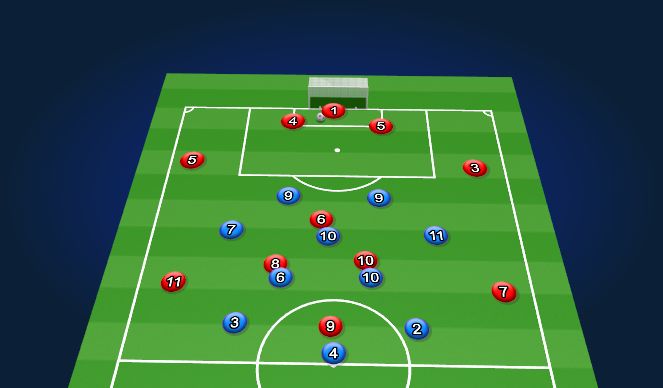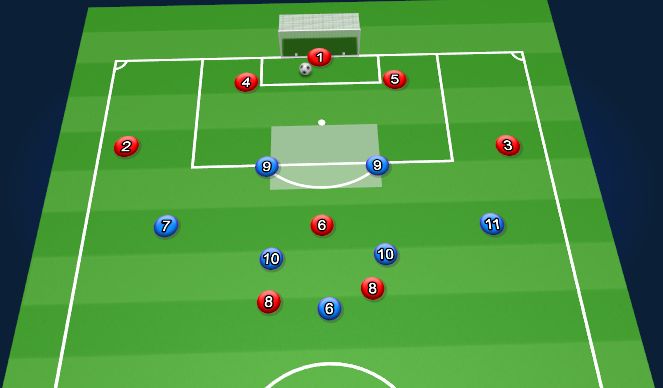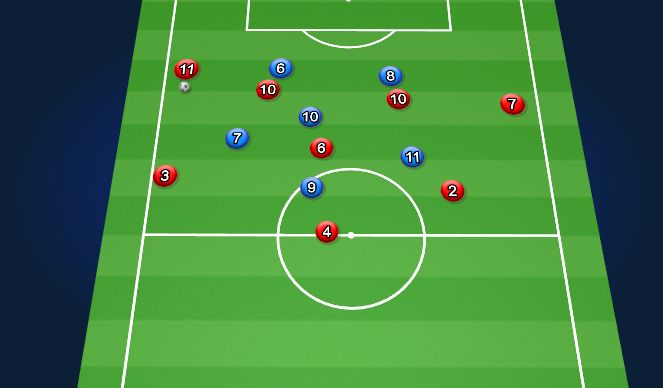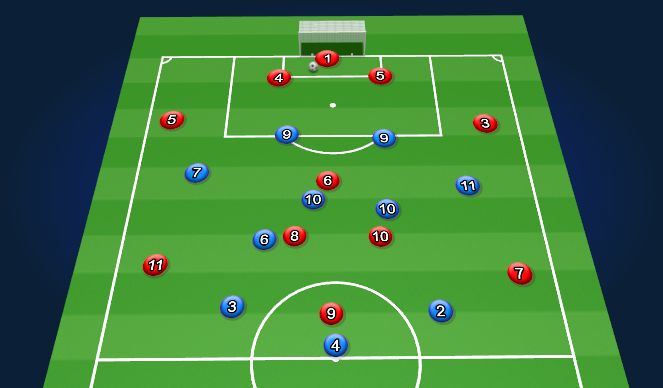Football/Soccer Session (Beginner): Pressing Structure
Profile Summary

| Name: | Ryan Curtis |
|---|---|
| City: | Corfu |
| Country: | United States of America |
| Membership: | Adult Member |
| Sport: | Football/Soccer |
Description

See the guidance at the top of this page to understand why you are not seeing interactive Football/Soccer images.

Midblock
Overview of Our Pressing Structure in the 3-5-2 Formation
Our pressing structure is an aggressive 3-5-2, designed to be a high pressing team focused on winning the ball back high up the pitch. We aim to lock teams into their own half and defend the halfway line as if it were our goal.
Player Roles in Pressing
Strikers
- Pressing Responsibilities: The strikers are responsible for pressing the opposition's center-backs.
- Tactics: If the opposition plays with 2 or 3 center-backs, the strikers must pressure the back line, forcing play to the outside.
Wingbacks
- Pressing Responsibilities: Wingbacks are tasked with pressing the opposition's deepest wide players, whether they are fullbacks or wingbacks, depending on the opposition's shape.
- Channel Blocking: It is crucial for wingbacks to block the channel pass, forcing the opposition to play inside where our central players are ready to challenge for the ball.
- Important Note: Wingbacks should not step up to press the opposition's center-backs, as this can break down our pressing structure.
- Recovery Runs: If wingbacks are dribbled past on the outside, their recovery run should be directed centrally, allowing our central midfielder to press the advancing fullback.
- Weakside Wingback: Weaksided wingback needs to drop and tuck in slightly to give preventative cover if the ball is successful switched to the oppositions Weaksided winger.
Central Midfielders
- Marking: All midfielders should employ a man-to-man, touch-tight approach, anticipating and intercepting central passes to opposition midfielders.
- Denying Switches: It is crucial to deny the opposition the opportunity to switch the point of attack through the midfield.
- Support Role: The strong-sided attacking midfielder will provide cover for the wingback if he is beaten on the dribble down the line.
- Bravery in Play: As we press high, the opposition may opt for direct play. Our midfield unit must be brave to win these direct duels and look to connect quickly once possession is regained.
Back 3
- Sliding Mechanism: Our three center-backs need to slide quickly to the side where the ball is played.
- If the ball is played to the left side, the left center-back must shift to engage the strong-sided winger.
- The center-back will slide across to pick up the striker.
- The weak-side center-back will also shift across, leaving the positioned winger to support the center-back.
Adaptation to Direct Play
If we are consistently successful in pressing and locking the opposition in their own half, they may resort to direct play as a means of countering our pressure. In such cases, we can transition to a mid-block formation.
- Mid-Block Strategy: This adjustment involves dropping our line of confrontation by about 15 yards, allowing us to maintain compactness and better position ourselves to win direct play. This approach helps us remain organized while still being prepared to challenge for the ball effectively.
Importance of Individual Battles
It is crucial for players to win their individual battles, as most matchups are 1 v 1. When players get beaten in these individual duels, we risk having to drop back and recover defensively. Direct play and quick transition moments can be particularly threatening for us, so we must stay organized in our pressing approach and in how we recover when we are broken down.

See the guidance at the top of this page to understand why you are not seeing interactive Football/Soccer images.

Attacking Transitions
When we successfully win the ball back in the attacking third, our objective is to get the ball to the "danger zone" as quickly as possible. This area, highlighted on the screen above, is crucial in transition moments. It will typically be occupied by our weak-side striker, who will look to set underneath an advancing attacking midfielder or combine with his striker partner.
To enhance our offensive transition strategy, we will focus on the following key elements:
- Immediate Awareness: Players must be alert immediately after winning the ball. They should recognize the best option for quickly advancing the play. We want to try and find our highest target possible.
- Support Movement: Encourage players to make supporting runs into the danger zone. This includes the weak-side striker, as well as midfielders making forward runs to create passing options.
- Communication: Effective communication is essential during transitions. Players should call out for the ball and signal for support to maintain the momentum of the attack.
- Decision-Making: Quick decision-making is crucial. Players should assess options rapidly and choose whether to pass, dribble, or shoot based on the situation.

See the guidance at the top of this page to understand why you are not seeing interactive Football/Soccer images.

Supporting
We need to ensure that our center-back and holding midfielder are providing support to our right and left center-backs when they have the ball in the channel. The center-back should slide and drop underneath the wide center-back to offer an option for switching play. Meanwhile, the defensive midfielder must provide a central option to facilitate switching the point of attack.








 Play animation
Play animation Play step-by-step
Play step-by-step Repeat (toggle)
Repeat (toggle) Full Screen
Full Screen Pause
Pause Stop
Stop
High Press
Overview of Our Pressing Structure in the 3-5-2 Formation
Our pressing structure is an aggressive 3-5-2, designed to be a high pressing team focused on winning the ball back high up the pitch. We aim to lock teams into their own half and defend the halfway line as if it were our goal.
Player Roles in Pressing
Strikers
Wingbacks
Central Midfielders
Back 3
Adaptation to Direct Play
If we are consistently successful in pressing and locking the opposition in their own half, they may resort to direct play as a means of countering our pressure. In such cases, we can transition to a mid-block formation.
Importance of Individual Battles
It is crucial for players to win their individual battles, as most matchups are 1 v 1. When players get beaten in these individual duels, we risk having to drop back and recover defensively. Direct play and quick transition moments can be particularly threatening for us, so we must stay organized in our pressing approach and in how we recover when we are broken down.
age